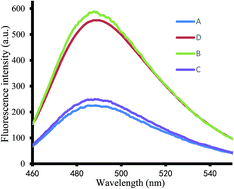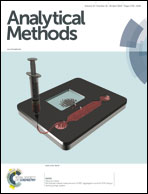A sensitive fluorescence method for the detection of streptavidin based on target-induced DNA machine amplification†
Abstract
Recently, small molecule and targeted protein interactions have been applied frequently in quantitative detection, with the streptavidin (SA)–biotin model attracting most attention. We address a novel SA detection method based on the terminal protection of a small-molecule-linked DNA probe from degradation by exonuclease I and G-quadruplex-thioflavin T complex fluorescence signal amplification. With the signal amplification strategy, a limit of detection as low as 0.065 nM was reached. The developed strategy provides a new route to a low cost and highly sensitive and selective method of detection of SA in real samples.



 Please wait while we load your content...
Please wait while we load your content...